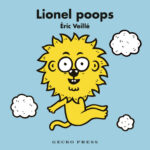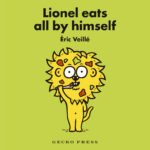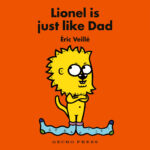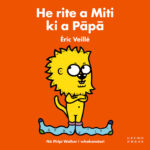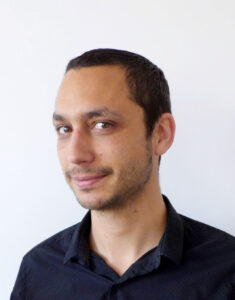 Éric Veillé was born in 1976 in Laval and studied at the Duperré School in Paris.
Éric Veillé was born in 1976 in Laval and studied at the Duperré School in Paris.
While working as an artistic director in publishing, he decided one spring day to devote himself to writing and children’s book illustration.
He has since released many books, as author and illustrator, including Encyclopedia of Grannies and My Pictures after the Storm. and the Lionel books: Lionel Poops, Lionel Eats All By Himself and Lionel Is Just Like Dad.
Who or what inspired the character of Lionel?
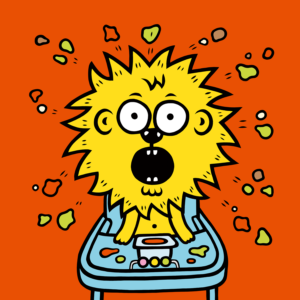
When I created the character of Lionel, I tried to reconnect with the deep feelings of two- and three-year-olds, and I found myself confronting some contrasting and powerful emotions!
It’s a very rich universe that you don’t always find in stories for toddlers, where things are often soft and kind. That’s why I chose to create Lionel—to let a “raw” and wild side come to the fore and rub up against reality.
How would you describe the relationship between Lionel and his dad?
In Lionel Is Just Like Dad, I wanted to work with the idea of imitation, which underpins learning. The father is a model for Lionel, who reproduces everything his father does down to the most insignificant or absurd details. Right up to the moment where Lionel’s father throws things randomly in the air … and Lionel imitates him—the turning point of the book.

An object Lionel throws lands on Dad’s head and he yells, “Ow!” Dad seems upset. There’s a little bit of uncertainty for Lionel … then the chance to reconcile with a hug.
The story could be seen as a summary of life, where we distance ourselves from our parents in order to
construct a self and return to them, loving them as they are. But an ultra short version—for toddlers!
What do you think makes a great dad?
I think it’s easier to be a good father if you know a little about yourself. For me, being a good father means being free. And trying to pass on that freedom to your children. Connection and love are important, but it’s almost more important for me to give them confidence and the freedom to discover who they are.
I often tell my children to look for what resonates with them, what gives them pleasure, what they are passionate about, and to turn that into a career … If we succeed in this, I think life will be beautiful! A good father is also, in my opinion, someone who knows how to enjoy the childhood of his children and shares it with them. In Lionel Is Just Like Dad, Lionel imitates his father, but I think there is also a lot of joy in imitating children, or at least listening to them. Children often have a poetic way of looking at the world.

Lionel is a cheeky and subversive toddler. How important do you think subversive children’s books are? Why?
 I think subversion is in my DNA. To be happy, I need to deconstruct the world around me every morning and imagine it differently. I think children also do this very naturally when they play. This means they can identify very easily with the cheeky character of Lionel, who doesn’t accept his world as it is—or at least tries to find his own way and sometimes takes surprising and terrible paths.
I think subversion is in my DNA. To be happy, I need to deconstruct the world around me every morning and imagine it differently. I think children also do this very naturally when they play. This means they can identify very easily with the cheeky character of Lionel, who doesn’t accept his world as it is—or at least tries to find his own way and sometimes takes surprising and terrible paths.
Subversion is life!
I used to ask my teachers provoking questions with a Lionel attitude when I was a child. But I made them laugh at the same time, so they didn’t hold it against me too much.
What are some of your favourite subversive characters in children’s literature?
The first that comes to mind is Tom Sawyer by Mark Twain. I particularly remember one sentence from the French captions of the cartoon adaptation: “He likes school, especially when it is far away…”
What tips do you have for adding humour to your art?
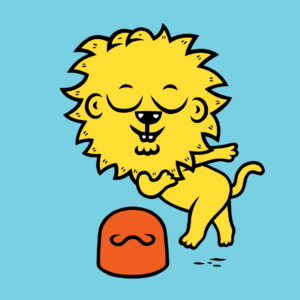 I don’t know if I have any tips or tricks, because I try not to fall into a pattern when I write. I often write a first draft, then go out for a jog or a bike ride and come back to rewrite it, trying to completely change the point of view and bring in a twist that comes from a totally different “me”. Then I go to the cinema.
I don’t know if I have any tips or tricks, because I try not to fall into a pattern when I write. I often write a first draft, then go out for a jog or a bike ride and come back to rewrite it, trying to completely change the point of view and bring in a twist that comes from a totally different “me”. Then I go to the cinema.
When I come back, I re-read my story. If I burst out laughing when I read it again, it’s often a good sign! Otherwise, I’m good to go to the pool.
What medium/tools do you use when you illustrate and what is your process?
I sketch on notebooks while I walk around. Then I draw with a black felt pen on paper sheets. I rework my drawings with a graphic tablet and apply colours chosen from a Pantone colour chart. For me, the drawing serves the idea. I emphasise action and the characters’ expressions—superfluous details don’t interest me. Sometimes I change my text to suit the drawings … for me, text and illustration are closely linked.
What did you love to draw when you were a child?
When I was a child, I drew horses, monsters and battles, as many children do. I participated in a competition where I had to imagine Laval (my city) in the distant future—the year 2000! I had fun.
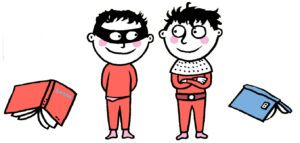
Read more about the Lionel board books, in which an overenthusiastic, impulsive lion cub tests his daily routines to their limit.
